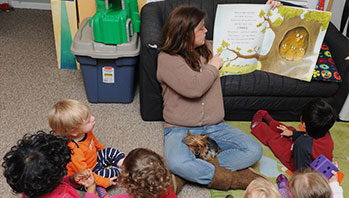- blend
- color
- environment
- mice
- mixed
- paint
MA Standards:
Literature/RL.PK.MA.1: With prompting and support, ask and answer questions about a story or a poem read aloud.
Literature/RL.PK.MA.6: With prompting and support, “read” the illustrations in a picture book by describing a character or place depicted, or by telling how a sequence of events unfolds.
Head Start Outcomes:
Literacy Knowledge/Book Appreciation and Knowledge: Asks and answers questions and makes comments about print materials.
PreK Learning Guidelines:
English Language Arts/Reading and Literature 6: Listen to a wide variety of age appropriate literature read aloud.
English Language Arts/Reading and Literature 10: Engage actively in read-aloud activities by asking questions, offering ideas, predicting or retelling important parts of a story or informational book.
Read Together: Mouse Paint BB

© Commonwealth of Massachusetts, Department of Early Education and Care (Jennifer Waddell photographer). All rights reserved.
STEM Key Concepts: There are many different colors; Two or more colors can be combined to make a new color
ELA Focus Skills: Concepts of Print, Interpreting Illustrations, Parts of a Book, Vocabulary, Speaking and Listening, Story Comprehension
Before You Read
Hold up Mouse Paint by Tana Hoban. Set a new reading focus for this reread by asking children to think about why the mice left some of the paper white at the end of the story.
As You Read
Help children determine why the mice keep either themselves or the paper white as they paint.
- Pause on the first illustration, ask, Why do you think the cat can’t find the three mice? (They are on white paper and they are white, so the cat can’t see them.)
- Pause on illustrations where the mice have painted themselves, ask, Do you think the cat would be able to find the mice now? Why do you think that?
- Pause on illustrations where the mice have painted the paper, ask, Do you think the cat would be able to find the mice now? Why do you think that?
After You Read
Show the last illustration. Say, Here are the mice at the end of the story.
- Why do you think the mice leave some of the paper white at the end of the story?
- What do you think might happen if the mice painted all the paper?
- Elicit children’s ideas about what is happening in this page and use the opportunitiy to continue the discussion on animal colorings and how some animals have colors that help them survive, or stay safe in their environment because they blend in, or change colors to fit, into their environment.
